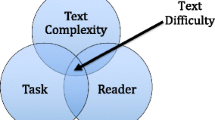Abstract
Textbooks are a major source in supporting instruction about reading across the world. Classroom teachers and school rely on these documents to guide the scope and sequence of instruction and expect them to provide evidence-based instructional guidelines to promote comprehension. Theories of reading comprehension are synthesized to identify vocabulary, generation of main ideas, summarization, and extrapolating inferences as sound constructs that promote comprehension. A review of textbooks from multiple continents show that most do not address evidence-based practices. Until the textbooks that support instruction on comprehension change, little can be accomplished by other means.
Similar content being viewed by others
References
Aaron, P. G., Joshi, R. M., Gooden, R., & Bentum, K. E. (2008). Diagnosis and treatment of reading disabilities based on the component model of reading: An alternative to the discrepancy model of L.D. Journal of Learning Disabilities, 41, 67–84.
Beerwinkle, A. L., Wijekumar, K., Walpole, S., & Aguis, R. (2018). An analysis of the ecological components within a text structure intervention. Reading and Writing: An Interdisciplinary Journal, 31(9), 2041. https://doi.org/10.1007/s11145-018-9870-5.
Bogaerds-Hazenberg, S. T. M., Evers-Vermeul, J., & van den Bergh, H. (2020). A meta-analysis on the effects of text structure instruction on reading comprehension in the upper elementary grades. Reading Research Quarterly. https://doi.org/10.1002/rrq.311.
Berkeley, S., King-Sears, M. E., Vilbas, J., & Conklin, S. (2016). Textbook characteristics that support or thwart comprehension: The current state of social studies texts. Reading & Writing Quarterly, 32, 247–272.
Curdt-Christiansen, X. L. (2020). Environmental literacy: Raising awareness through Chinese primary education textbooks. Language, Culture and Curriculum,. https://doi.org/10.1080/07908318.2020.1797078.
Joshi, R. M., Binks, E., Graham, L., Dean, E., Smith, D., & Boulware-Gooden, R. (2009). Do textbooks used in university reading education courses conform to the instructional recommendations of the National Reading Panel? Journal of Learning Disabilities, 42, 458–463. https://doi.org/10.1177/0022219409338739.
Kintsch, W., & van Dijk, T. A. (1978). Toward a model of text comprehension and production. Psychological Review, 85(5), 363–394. https://doi.org/10.1037/0033-295X.85.5.363.
Kintsch, W. (1988). The role of knowledge in discourse comprehension: A construction-integration model. Psychological Review, 95, 163–182.
Kintsch, W. (2005). An overview of top-down and bottom-up effects in comprehension: The CI perspective. Discourse Processes, 39, 125–128.
Meyer, B. J. F. (1975). The organization of prose and its effects on memory. Amsterdam: North Holland Press.
Meyer, B. J. F., & Poon, L. W. (2001). Effects of the structure strategy and signaling on recall of text. Journal of Educational Psychology, 93, 141–159.
Pearson, P. D., & Cervetti, G. N. (2015). Fifty years of reading comprehension theory and practice. In P. D. Pearson & E. H. Hiebert (Eds.), Research-based practices for teaching common core literacy (pp. 1–24). New York, NY: Teachers College Press.
Perfetti, C., & Stafura, J. (2014). Word knowledge in a theory of reading comprehension. Scientific Studies of Reading, 18, 22–37. https://doi.org/10.1080/10888438.2013.827687.
Schmalhofer, F., McDaniel, M. A., & Keefe, D. (2002). A unified model for predictive and bridging inferences. Discourse Processes, 33, 105–132.
United Nations Educational, Scientific, and Cultural Organization Institute for Statistics (UIS). (September 2017). More than one-half of children and adolescents are notlearning worldwide. Fact Sheet No. 46 (UIS/FS/2017/ED/46). Retrieved from http://uis.unesco.org/sites/default/files/documents/fs46-more-than-half-children-not-learning-en-2017.pdf
Van den Broek, P. (2005). Integrating memory-based and constructionist processes in accounts of reading comprehension. Discourse Processes, 39(2–3), 299–316.
van den Broek, P., Rapp, D. N., & Kendeou, P. (2005). Integrating memory-based and constructionist processes in accounts of reading comprehension. Discourse Processes, 39, 299–316.
van den Broek, P., Young, M., Tzeng, Y., & Linderholm, T. (1999). The landscape model of reading: Inferences and the on-line construction of a memory representation. In H. van Oostendorp & S. R. Goldman (Eds.), The construction of mental representations during reading (pp. 71–98). Mahwah, NJ: Lawrence Erlbaum Associates.
Wijekumar, K., Meyer, B. J. F., & Lei, P. (2012). Large-scale randomized controlled trial with 4th graders using intelligent tutoring of the structure strategy to improve nonfiction reading comprehension. Journal of Educational Technology Research and Development, 60, 987–1013.
Wijekumar, K., Meyer, B. J. F., Lei, P., Lin, Y., Johnson, L. A., Shurmatz, K., & Cook, M. (2014). Improving reading comprehension for 5th grade readers in rural and suburban schools using web-based intelligent tutoring systems. Journal of Research on Educational Effectiveness, 7, 331–357. https://doi.org/10.1080/19345747.2013.853333.
Wijekumar, K., Meyer, B. J. F., & Lei, P. (2017). Web-based text structure strategy instruction improves seventh graders’ content area reading comprehension. Journal of Educational Psychology, 109, 741–760. https://doi.org/10.1037/edu0000168.
Wijekumar, K., Beerwinkle, A., Owens, J. K., & Lambright, K. (2020). Teacher professional development guide. Center for Urban School Partnerships, College Station, TX: Texas A&M University.
Author information
Authors and Affiliations
Corresponding author
Additional information
Publisher's Note
Springer Nature remains neutral with regard to jurisdictional claims in published maps and institutional affiliations.
Rights and permissions
About this article
Cite this article
Wijekumar, K., Zhang, S., Joshi, R.M. et al. Introduction to the Special Issue: Textbook Content and Organization—Why it Matters to Reading Comprehension in Elementary Grades?. Tech Know Learn 26, 243–249 (2021). https://doi.org/10.1007/s10758-021-09505-6
Accepted:
Published:
Issue Date:
DOI: https://doi.org/10.1007/s10758-021-09505-6




